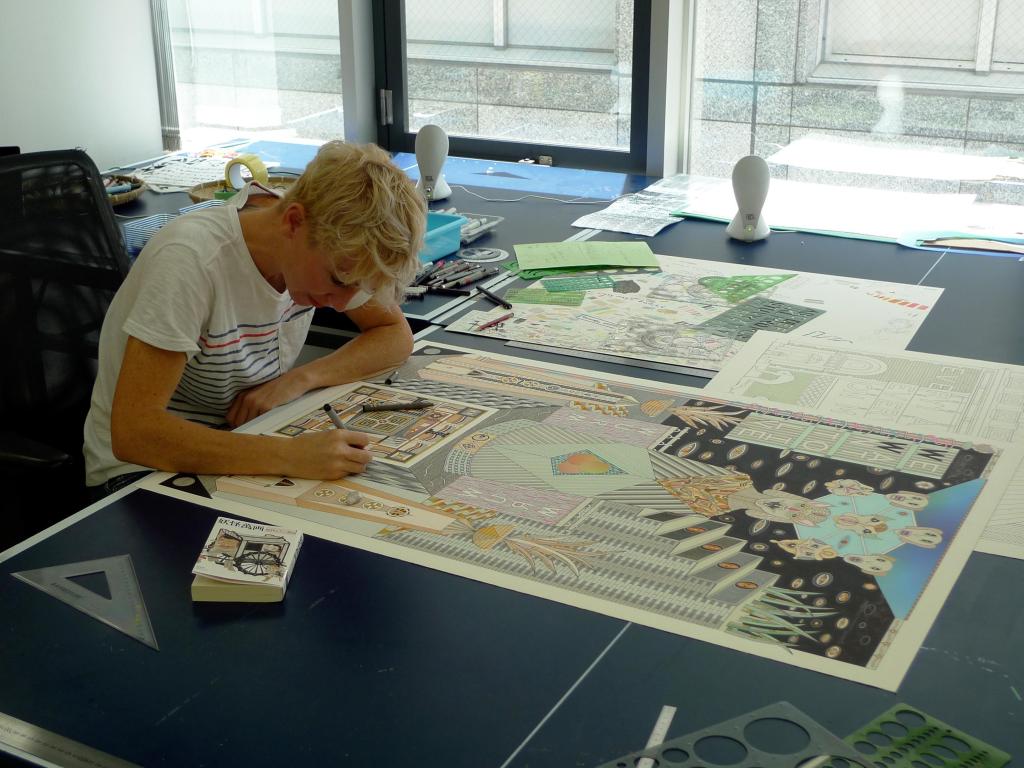Artist Jess Johnson at work during her residency at Tokyo Wonder Site in 2013 (Credit: Asialink)
Asialink’s Arts Residency Program has been offering residencies for over two decades with the aim of building ‘Asia capability via cultural exchange’.
With the application round now open for the 2015 artist residencies at Asialink, artists and arts practitioners will be pleased to know that the program is growing in terms of international networks, funding and opportunities for artists every year.
Arts Residences Manager Eliza Roberts said, ‘Our program is always evolving; it’s been going for 23 years now. The 2015 residents have new hosts and new residency models that they can apply for. Over the past few years we have started taking the program in different directions slightly.
‘We are forming partnerships with new residency networks, and these are guiding our direction.’
Asialink has an affiliation to ResArtis, an international residency network. Roberts, who is also the vice president of the association, said, ‘It advocates for international cultural mobility and works with people who want to set up residency spaces, to develop toolkits and things like that.
‘They have also got the largest database of art residencies internationally online which is accessible, and this is of benefit for the artists who can access this database.’
Visual artist Jess Johnson, who went to Japan’s Tokyo Wonder Site as part of the 2013 Reciprocal Residency program with the Victorian College of the Arts, Melbourne, felt that the experience was very fruitful, mostly because of being physically located in Tokyo for three months.
‘Long-term residencies are incredibly formative and expanding for artist’s practices, personal outlook and professional careers. Essentially I wanted the experience of being ‘away’. To be isolated, confused, challenged, inspired … all of these experiences can be formative and fed back into your art practice.’
‘I used the opportunity of being away from Melbourne to really dedicate myself to intensive studio time. I didn’t have the normal distractions taking me away from the studio so I was able to spend long chunks of time in the studio.
‘I completed eight large-scale drawings while in Tokyo, which were exhibited at the Museum of Contemporary Art in Sydney as part of their Primavera 13 exhibition,’ said Johnson.
The works she completed as part of her residency later travelled back to Melbourne and were exhibited at ‘Melbourne Now’ at the National Gallery of Victoria and eventually acquired by the NGV for their collection.
Roberts believes the residencies are a great professional development opportunity for the artists.
‘Nowadays when collectors or galleries are looking at an artist’s CV, residencies are an integral part of that professional experience, but it is also an opportunity for them to give something back to the host and the host community as well.’
Contemporary Taiwanese musician of the traditional Chinese stringed instrument Pipa, Pei-Ju Lien was part of the 2013 Reciprocal Residency at Fremantle Arts Centre, (FAC) WA. She collaborated with local musicians on a number of contemporary compositions. This resulted in a farewell concert Journey on the road: Peiju and her new friends, performed at FAC.
‘I tried to introduce this instrument and music style to the local audience. Then I opened the workshop to welcome anyone who was interested and willing to try cross fusion music. I think my attitude was very open-minded.
‘I had a very clear objective to find a didgeridoo player in WA. I had learned from the musicians I have met during my residency,’ said Lien.
But amid such fertile cultural exchanges, do artists ever feel the lack of tools to deal with local languages, customs and traditions? Roberts says the program has introduced information sessions that target exactly these issues.
‘For the first time this year we have done an in-person orientation which we call a one-day Asia Capability Orientation. It was an opportunity for the new round of residents for 2014 to connect up with each other but also with past Asialink residents to the country and the host that they were going to.
‘We guided them through an induction process of pre-departure information and how to make the most of a residency, life after a residency and through that day we outlined ways that they could engage with their hosts in a more meaningful way.
‘One of these is by taking language lessons and they can use their Asialink grant to do that and that’s something we actively encourage. Many residents have found that it is the best way of creating increased engagement,’ she said.
Roberts feels that art residencies and arts and culture in general offer many ways of breaking down those cultural and language barriers, both through performance art and visual art as well.
Singapore-based artist Angie Seah, who is on a 2014 Reciprocal Residency at the Victorian College of the Arts, Melbourne, feels being away from home makes very little difference.
‘Actually I never really feel lonely; I took this isolation from Singapore in a very positive manner. Everywhere I go there are human beings, so why should I feel lonely or excluded.
‘I should be welcoming myself to get to know the place, the people and that’s our knowledge as artists – to have an experience. And that’s the most brilliant thing ever.’
The 2015 round has opened for applications and will close on 30 September, 2014. To apply, click here. Or read here for frequently asked questions about the Arts Residency Program.





